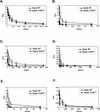Tripalmitoyl-S-glyceryl-cysteine-dependent OspA vaccination of toll-like receptor 2-deficient mice results in effective protection from Borrelia burgdorferi challenge
- PMID: 12819074
- PMCID: PMC161983
- DOI: 10.1128/IAI.71.7.3894-3900.2003
Tripalmitoyl-S-glyceryl-cysteine-dependent OspA vaccination of toll-like receptor 2-deficient mice results in effective protection from Borrelia burgdorferi challenge
Abstract
Toll-like receptor 2 (TLR2) is a transmembrane signal transducer for tripalmitoyl-S-glyceryl-cysteine (Pam(3)Cys)-modified lipoproteins, including OspA from the Lyme disease spirochete Borrelia burgdorferi. The Pam(3)Cys modification provides adjuvant activity for inducing humoral responses, suggesting that TLR2 could function as the adjuvant receptor for the OspA vaccine. The importance of TLR2 in the humoral response to OspA was confirmed, because overall levels of immunoglobulin G (IgG) were reduced in TLR2-deficient mice, when compared with those in wild-type mice. However, the levels of production of IgG1 were similar in both mouse strains, and the levels of induction of protective immunity were comparable. Unlipidated OspA was not immunogenic in wild-type or TLR2-deficient mice, indicating the lipid modification was active in the absence of TLR2. These findings indicate that the Pam(3)Cys modification of bacterial lipoprotein has adjuvant properties independent of TLR2 signaling.
Figures




References
-
- Akira, S., K. Takeda, and T. Kaisho. 2001. Toll-like receptors: critical proteins linking innate and acquired immunity. Nat. Immunol. 2:675-680. - PubMed
-
- Alexopoulou, L., V. Thomas, M. Schnare, Y. Lobet, J. Anguita, R. T. Schoen, R. Medzhitov, E. Fikrig, and R. A. Flavell. 2002. Hyporesponsiveness to vaccination with Borrelia burgdorferi OspA in humans and in TLR1- and TLR2-deficient mice. Nat. Med. 8:878-884. - PubMed
-
- Aliprantis, A. O., R. B. Yang, M. R. Mark, S. Suggett, B. Devaux, J. D. Radolf, G. R. Klimpel, P. Godowski, and A. Zychlinsky. 1999. Cell activation and apoptosis by bacterial lipoproteins through toll-like receptor-2. Science 285:736-739. - PubMed
-
- Barthold, S. W., D. S. Beck, G. M. Hansen, G. A. Terwilliger, and K. D. Moody. 1990. Lyme borreliosis in selected strains and ages of laboratory mice. J. Infect. Dis. 162:133-138. - PubMed
-
- Bessler, W. G., B. Suhr, H. J. Buhring, C. P. Muller, K. H. Wiesmuller, G. Becker, and G. Jung. 1985. Specific antibodies elicited by antigen covalently linked to a synthetic adjuvant. Immunobiology 170:239-244. - PubMed
Publication types
MeSH terms
Substances
Grants and funding
- R29 AI043521/AI/NIAID NIH HHS/United States
- R01 AI024158/AI/NIAID NIH HHS/United States
- AI-43521/AI/NIAID NIH HHS/United States
- 5P30-CA-42014/CA/NCI NIH HHS/United States
- P51 RR000164/RR/NCRR NIH HHS/United States
- R01 AI049976/AI/NIAID NIH HHS/United States
- AI-32223/AI/NIAID NIH HHS/United States
- R01 AI043521/AI/NIAID NIH HHS/United States
- RR00164/RR/NCRR NIH HHS/United States
- AI49976/AI/NIAID NIH HHS/United States
- R56 AI032223/AI/NIAID NIH HHS/United States
- AI-24158/AI/NIAID NIH HHS/United States
- R01 AI032223/AI/NIAID NIH HHS/United States
- P30 CA042014/CA/NCI NIH HHS/United States
LinkOut - more resources
Full Text Sources
Other Literature Sources
Medical
Miscellaneous

